Celebrate Cesar Chavez Day by looking back at his time spent in Austin and Texas
- Oops!Something went wrong.Please try again later.
Cesar Chavez Day is on Sunday.
Former President Barack Obama designated March 31 a commemorative holiday for the Mexican American union organizer in 2014. The day marks the anniversary of his birth.
Chavez was born in 1927 to migrant farmworker parents in Arizona. In 1962, he helped found the National Farm Workers Association — known today, after mergers, as the United Farm Workers union — in Delano, California, and spent the following decades advocating for improved wages and labor conditions for field workers. In the 1960s and 1970s, Chavez's campaign of weekslong fasts and monthslong marches brought unprecedented national attention to the union's bargaining fights with California table grape growers and the plight of its predominantly Mexican and Filipino American members. He died in 1993.
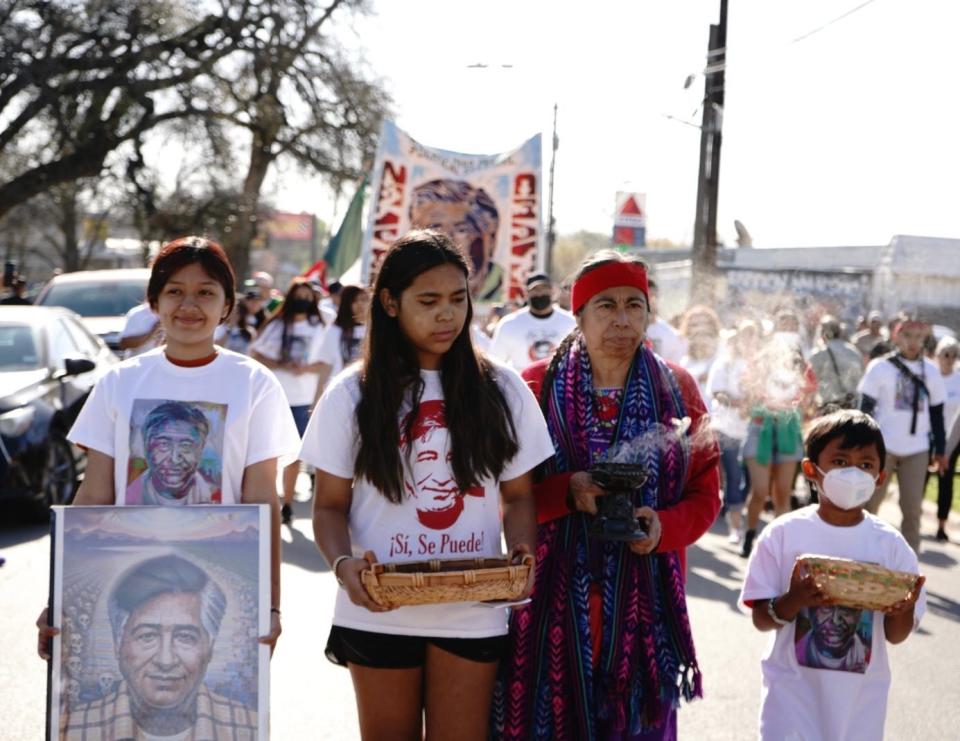
Chavez's influence was strongest in California, but his attempt to organize farmworkers in South Texas and his interest in Mexican American communities and their politicization throughout the southwest brought him to Austin time and time again. In the capital city, he made boycott speeches, attended campus talks and showed solidarity with several East Austin community efforts.
These days, many residents celebrate Chavez's legacy through a yearly march. This year's iteration will leave Parque Zaragoza at 10 a.m. on Saturday.
Who was Menchaca? Del Valle? Guerrero? The stories behind Austin's Hispanic place names.
Cesar Chavez in Austin, through the years
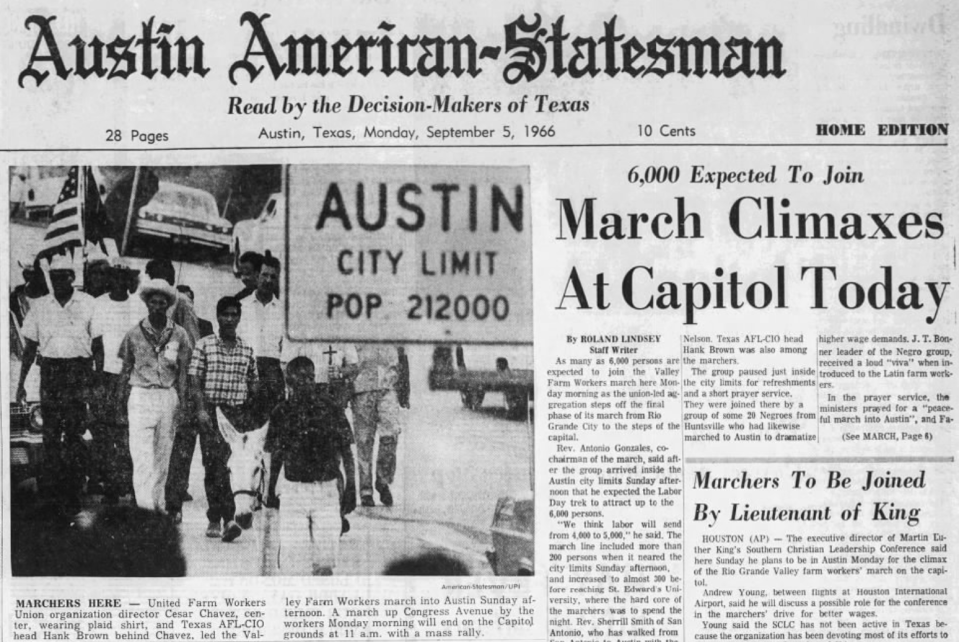
Sept. 5, 1966:
Sept. 5, 1966: On Labor Day of that year, Chavez led a rally at the statehouse steps to cap a 400-plus-mile march by farmworkers from Rio Grande City. The marchers, who included some of the first UFW members in Texas, demanded a $1.25 minimum wage and had been en route since the Fourth of July. The American-Statesman reported the gathering drew as many as 6,000 attendees.
Feb. 7, 1971:
Feb. 7, 1971: The Statesman reported that Chavez had stopped in town to pledge his support to the upholsterers’ strike against Economy Furniture, known in local memory as the Chicano Huelga. He called for people to continue boycotting Economy Furniture’s client Montgomery Ward and touted union solidarity. The Statesman described him as “a man of average height and build who comes on quietly but projects a sense of determination in his unassuming manner.”
The upholsterers' union effort was almost 3 years old at the time of Chavez’s visit. Its eventual success, many East Austin Mexican Americans have said, inspired its first wave of elected leaders.
Chavez’s visit was preceded by much local excitement. A week prior, the Travis County Commissioners Court pronounced the day of his visit “Cesar Chavez Day” (a resolution commending the organizer failed in the Texas Legislature). The night before his strike appearance, a crowd of 2,000 had greeted Chavez’s plane with chants of “Chicano power.”
More: March returns to East Austin to honor César Chávez
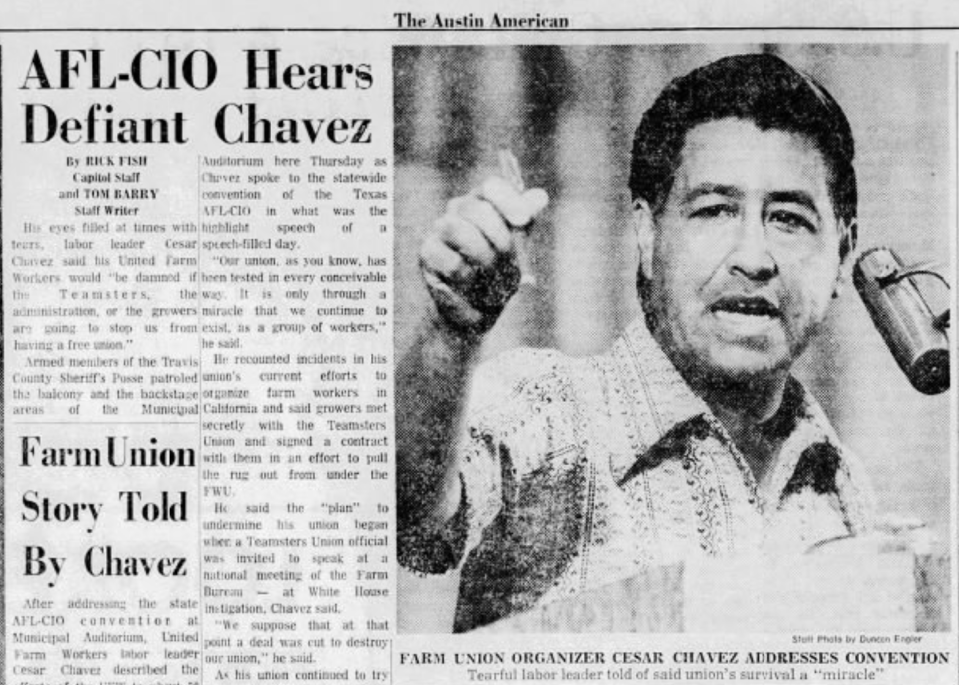
July 13, 1973:
July 13, 1973: Amid a storied fight with the Teamsters union, Chavez spoke at the Texas AFL-CIO conference in Austin. He accused the the Teamsters and other opponents of a concerted effort to undercut his union’s organizing efforts. He asked for the support of union leaders.
“Our union, as you know, has been tested in every conceivable way. It is only through a miracle that we continue to exist as a group of workers,” Chavez said. The Statesman described him as “tearful.”
After that, Chavez — a devout Catholic who imbued his rhetoric with spiritual righteousness — went to speak and attend Mass at Cristo Rey Church.
July 27, 1979:
July 27, 1979: At a speech at that year's Texas AFL-CIO conference in Austin, Chavez complained that undocumented immigrants were being used to break his union's seven-month strike on United Brands lettuce growers. Chavez said his union was at a financial breaking point because of the length of the strike and needed support. Chavez's frequent opposition to undocumented immigrants, and the mobilization of his union against them, has led some to criticize his legacy.
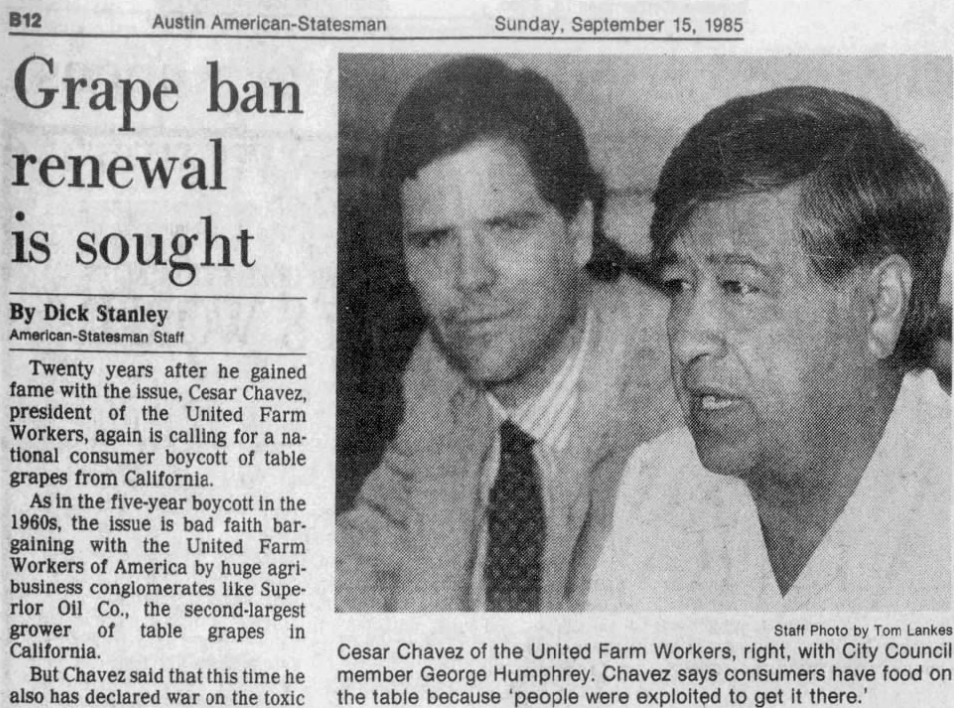
Sept. 15. 1985:
Sept. 15. 1985: Speaking at UT, Chavez touted his most recent table grape boycott to oppose the use of pesticides around farmworkers and in food. The Austin City Council and Travis County Commissioners Court passed supportive resolutions. “We never got these resolutions 20 years ago. We will take them elsewhere and use them to shame others into supporting us,” the Statesman reported Chavez saying.
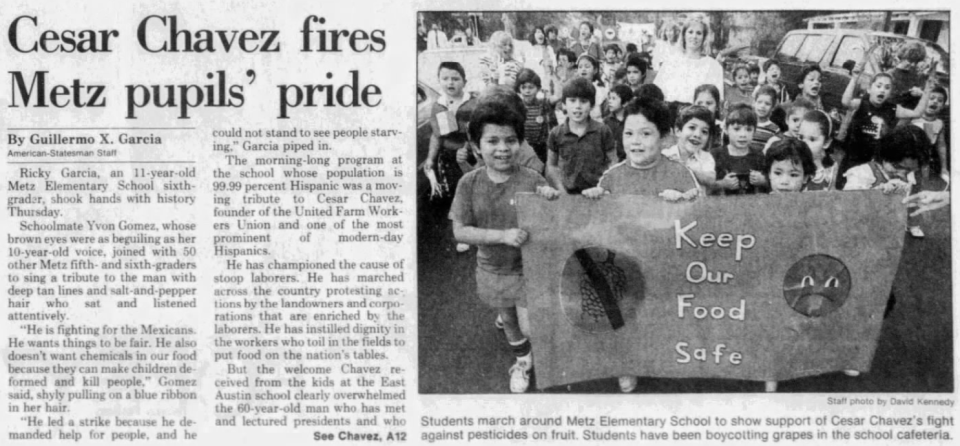
Oct. 16, 1987:
Oct. 16, 1987: Chavez visited the state capital as part of a state tour commemorating the 25th anniversary of the UFW’s large-scale grape boycott and publicizing the adverse effects of pesticides. His visit included a stop at Metz Elementary School, where the student body marched around the school waving UFW flags that said “Metz saluda” and a banner that said “keep our food clean.” Metz was 99.99% Hispanic at the time, the Statesman reported.
“I have never been welcomed like this in my life, and I will never forget it,” Chavez said.
Chavez asked those in attendance to stop eating California grapes. He was assured that the schoolchildren had honored his this at the school cafeteria for the past two weeks.
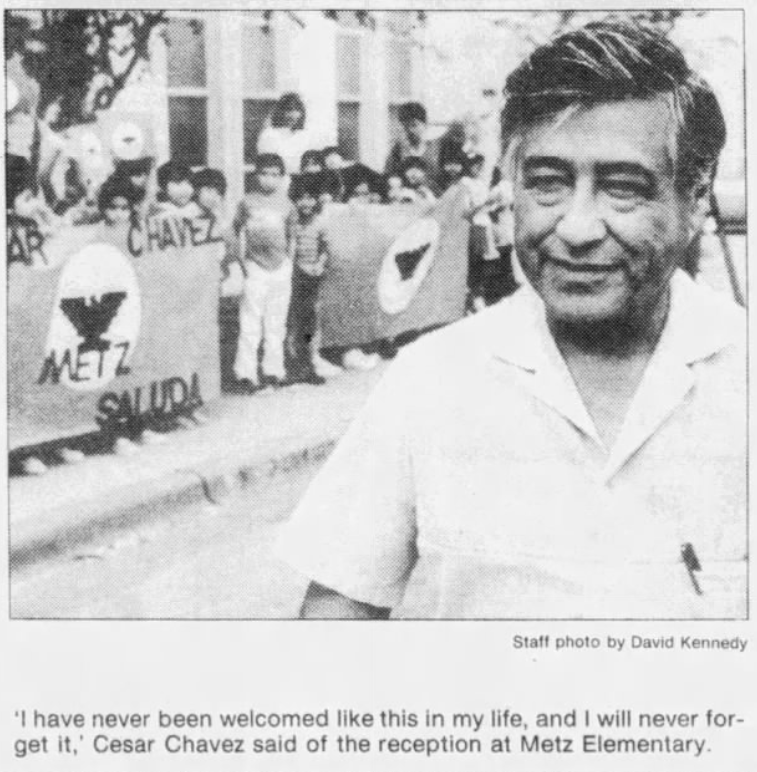
Sept. 17, 1993:
Sept. 17, 1993: A few months after his death, the Austin City Council renamed First Street after the late union leader. State highway officials requested for $154,728 to new signage on MoPac Boulevard, Interstate 35 and U.S. 183, prompting city leaders to say they would prioritize changing city signs first.
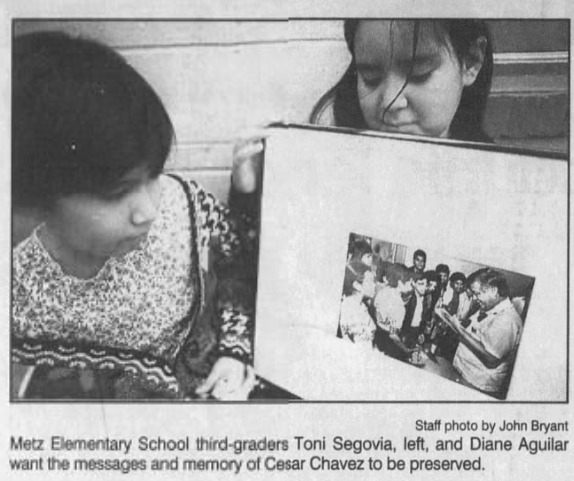
Dec. 2, 1993:
Dec. 2, 1993: A Statesman article voiced the laments of Metz Elementary School students over Chavez’s death. He had been expected to visit the school at the time of his passing. School teacher Lupe Ramos said the students had asked the district to remove grapes from cafeterias and H-E-B to not carry picket-crossing grapes after learning about the leader.
Two days later, the city held the first Cesar Chavez march to commemorate First Street’s renaming. It was attended by UFW leadership and Chavez’s daughter.
The Statesman did not accent Chavez's name as is done in the Spanish linguistic tradition because Chavez himself did not. The Austin parade does accent the union leader's name.
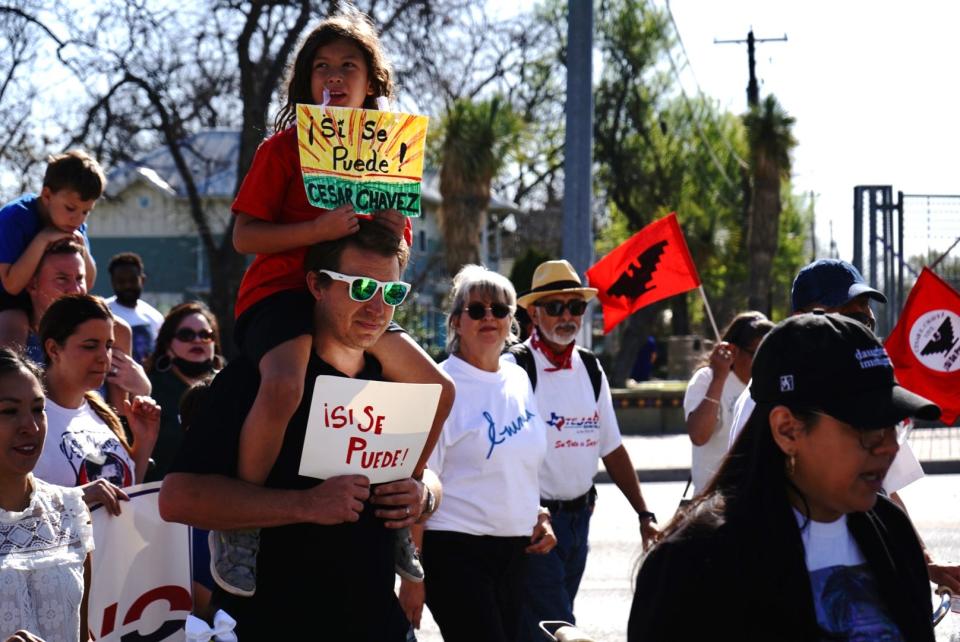
This article originally appeared on Austin American-Statesman: Cesar Chavez spent time in Austin and Texas: What the archives show.

